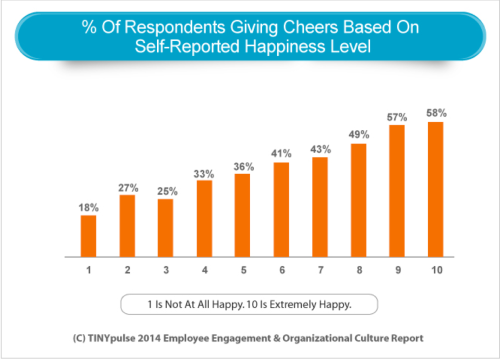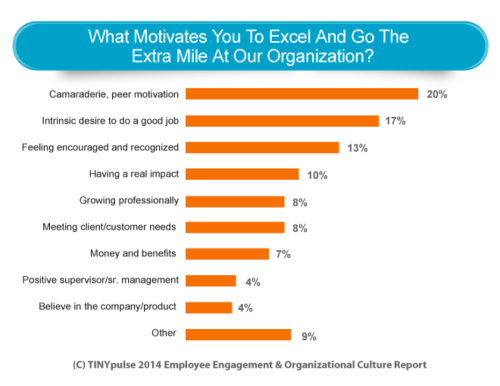What motivates employees? It is money? Feeling valued at work? Connecting with a company’s social mission? All these are good answers, but a new study from TINYpulse that analyzed over 200,000 employee responses relating to organizational culture found that peers and camaraderie are the #1 reason employees go the extra mile. While peer recognition and camaraderie might seem like two aspects of company culture that happen (or need to happen) organically, there are ways organizations can promote a culture that fosters peer recognition and camaraderie. As a potentially overlooked area of focus for organizations, peer recognition is a valuable way to foster a positive culture and create one where employees regularly “go the extra mile.” 44% of employees surveyed report that when they are provided a simple tool to do so, they will provide peer recognition on an ongoing basis. The happier the employee, the bigger the praise: 58% of “happy” employees report giving regular peer recognition, compared to 18% of the least happy employees. As TINYpulse states, “Professional happiness encourages 3X more recognition!”
Thinking that money motivates employees seems an antiquated line of thought when looking at TINYpulse’s data. In fact, money isn’t even among the top 5 factors that motivate employees to go the extra mile. Out of 10, “money and benefits” ranks #8. The top 3 motivators for employees to go the extra mile are:
- Camaraderie/peer motivation
- Intrinsic desire to do a good job, and
- Feeling encouraged and recognized
Feeling encouraged and recognized at work can stem from a number of different sources, but regardless of where recognition most often occurs, TINYpulse’s data show that employees feel significantly undervalued overall. On a 1-10 scale, just 21% of all employees gave a score of nine or ten for feeling valued at work, meaning that 79% of employees feel undervalued, or not valued at all.
Camaraderie and recognition have broader implications than just creating a more motivated workforce. Workplace cultures that embrace these are no longer expected to be just the few and far between: job seekers expect this of organizations, and they are ways to not only attract talent, but to retain it. Millennials especially (as I’ve discussed in past posts) place a high value on camaraderie and actively seek out such work environments. TINYpulse sites a recent report by Bersin and Associates, which found that employee engagement, productivity, and customer service, are about 14% better in organizations where recognition occurs.
Consider how your organization recognizes its employees – how do you recognize peers? Do employees at your organization feel valued – do you? Maybe it’s time to institute some formal recognition programs, which we here at Great Place To Work consistently see as best practices at organizations on the FORTUNE 100 Best Companies to Work For list. “Ramping up” recognition programs doesn’t need to mean excessive time or investment either. It could be as simple as instituting a gold star program, installing a white board in the break room for “biggest save of the week” comments, or having an employee mentor another for an hour on a specific skill. Our advice is to start small, and build on positive outcomes.
But by all means, provide formal and informal ways for your employees to recognize the contributions of their peers – that is, if you’d like more of your employees to go the extra mile for your customers!










